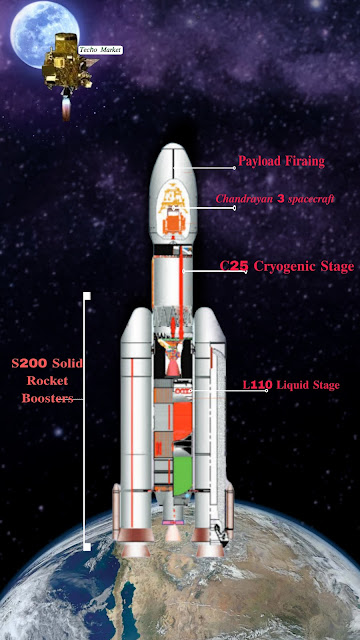Hello 🅃🄴🄲🄷🄽🄾🄻🄾🄶🅈 🅅🄸🄴🅆🄴🅁🅂 …
I'm very happy to talk about
🇨 🇭 🇦 🇳 🇩 🇷 🇦 🇾 🇦 🇳 MISSION SUCCESSFUL STORY step- by-step, Complete details of all CHANDRAYAN, Mark-3 and what are future plans ISRO
Actually i am going to give you information about All CHANDRAYAN mission how they failed or success to reach on MOON because its very important mission as for ISRO, INDIAN SCIENTIST.
Firstly i am going to summarise this important LUNAR EXPLORATION for better understanding.
IN SHORT ABOUT COMPLETE CHANDRAYAN MISSION
The CHANDRAYAN PROGRAMME
- It's an unmanned lunar mission under the leadership of indian space research organisation (ISRO).
- It's aim to study "thermal condition" topography Minerals polar regions structure water and ice volatile of the moon..
- Consist of three mission Chandrayaan 1 chandrayan 2, chandrayan 3.
𝘾𝙝𝙖𝙣𝙙𝙧𝙖𝙮𝙖𝙖𝙣 1
- launched in 2008 and orbited the moon for about a year
- made several discoveries such as presence of water molecules on the lunar surface..
𝘾𝙝𝙖𝙣𝙙𝙧𝙖𝙮𝙖𝙖𝙣 2
- Launched in 2019 and consisted of an ORBITER, A LANDER with A ROVER.
- It's aimed to land on SOUTH POLE of the moon and perform scientific studies.
- At last it FAILED and CRASHED on the moon surface..
𝘾𝙝𝙖𝙣𝙙𝙧𝙖𝙮𝙖𝙖𝙣 3
- launched in 2023 it consisted a LANDER and ROVER
- reattempt to land on LUNAR surface as like CHANDRAYAN 2.
- finally it successfully landed on south pole of moon on 23 August 2023 and became first to do so..
It's MOON MISSION
The CHANDRAYAN MISSION is India's intiative to explore and study the nature and environment of moon using ROBOTIC SPACECRAFT with scientific equipments.
Actually it is started much before today , first chandrayan was launched in 2008 and it orbited the moon for about one year.it also carried many scientific instruments of different countries and made numerous discoveries like presence of WATER MOLECULES on the lunar surface.
The second CHANDRAYAN was launched in 2019 and it consisted three category payloads a lander a rover and orbiter.. it's aim is to land on the south pole of the moon and carried 14 days scientific experiments .
I am going to elaborate a little bit more about the spacecraft of CHANDRAYAN 2.
The lander named VIKRAM and the rover named prayagan which aimed to land on south pole junction on moon and perform several scientific experiments for 14 days..
And the orbiter which carried 8 instruments is still operation today..But a bad news came after spacecraft reached near the lunar surface the lander VIJRAM lost contact with ISRO during landing process and it crashed on the moon surface. The exact reason of failure still unknown.
After chandrayan 2 failure ISRO announced another attempt to land on the south pole of moon and they named chandrayan 3 ..actually this mission was scheduled in 2020 but due to covid and other some difficulties this mission was postponed till 2023.
Now We look forward on CHANDRAYAAN-3
Chandrayan 3 all started like chandrayan 2 but they excluded the orbiter in this mission. They also reduced the cost of mission by reusing the spare parts of chandrayan 2.
Chandrayan 3 consist of only two components this time the propulsion module and the rover CONFIGURATION, actually propulsion module is responsible for carrying the lander rover configuration.
The landr rover configuration module consist of the lander VIKRAM and the rover PRAGYAN same as chandrayan 2.
ANOTHER MAIN PART OF CHANDRAYAN IS LANDER
The lander is designed to soft landing on the lunar surface by using 4 throttleable engines. But its not easy to deploy rover on the lunar surface so they used a ramp to do this..
LAST BUT IMPORTANT PART IS ROVER
The way it is designed to move on six wheels and carry 2 scientific instruments along with: alpha particle Xray spectrometer(APXS)and a laser induced breakdown spectrometer (LIBS)..
The LANDER VIKRAM also carries 4 other scientific instruments: a radio anatomy of moon bound hypersensitive ionosphere(RAMBHA), and a Chandra's surface thermal - physical experiment (ChaSTE), a lunar seismic activit(ILSA),and a laser retroreflector array(LRA)..
Now I am going to give you some basic information about this CHANDRAYAN 3 ROBOTIC SPACECRAFT .
This chandrayan 3 spacecraft is about 3900 kg mass of which 2148 kg is the propulsion module , 1726 kg is the lander module and rest 26 kg is for the rover module.
The power required to run all this is 758 watt for propulsion module ,738 watt for lander module with bias and for the rover module we just need 50 watt.
Information related to launched date and duration of chandrayan 3 (ISRO).
ISRO decided to launch chandrayan 3 on 14 July 2023 from Satish Dhawan space research centre in Harikota using a launch vehicle mark- 3( LVM3) rocket.
As scheduled it launched. The total mission is expected to be about four and half month. This total time divided for three configurations.one month for the propulsion module ,and upto three month for the lander module and 14 days for rover module.
MORE ABOUT the ROCKET used to launched CHANDRAYAN 3, is the mark-3.
The LVM3 is one of the India's most powerful rocket , capable of launching upto four tonns of payload into geostationary transfer ORBIT. LVB3 consist of two solid strap on booster and a liquid corestage and a cryopenic upper stage.
ISRO launched chandrayan 3 successfully and it was injected into the elliptical GTO with an apogee( farthest point from the Earth)of about 3600 km and a perigee( closest point to the Earth)of about 170 km. After separation from from rocket(LVM3), the chandrayan 3 performed five raising orbit operation using it's propulsion module to increase it's apogee gradually untill it reached to the adjacent of the moon's orbit. After that it performed a trans lunar injection(TLI) operation to escape from the Earth's gravity and enter into a lunar transfer trajectory..
We all know that Chandrayan3 reached the moon's orbit on 5th August 2023 and performed a lunar orbit insertion(LOI) Operation to enter in an elliptical orbit around the moon. We should know about the two points of moon one is apocynthion( farthest point from the moon) and second is pericynthion ( closest point from the moon). After enter chandrayan3 started it's four orbit operation to reduce the apocyntion from 163km to 100km and pericynthion from 153km to 30 km respectively.
- Chandrayan 3 successfully land on the lunar surface on 23 August 2023at 18:02 IST. For ISRO this region is very important for scientific point of view because it is expected that South polar region have high concentration of water and ice and other volatile which may hide in dark of this region. And also for India it is important for communication purpose and duration of light for power generation strategy.
Now We look at Step By Step explaining sequence of landing of CHANDRAYAN 3.
- There are four sequences in landing.
Rough braking
Altitude control
Fine braking
Terminal descent.
Now we know more about 4 sequences involved in the landing.
-The ROUGH BRAKING started when Chandrayan3 was about 30km above the lunar surface and lasted for about 10 minutes. This phase is very important because during this phase Chandrayan 3 used it's propulsion module to reduce it's velocity from 1.6 km/s to 140 m/s.
-ALTITUDE CONTROL l phase started when Chandrayan3 was about 7.4 km above the lunar surface and it will lasted about 38 seconds. This phase is also very crucial because during this phase Chandrayan3 separated from its propulsion module and given itself for the landing using its reaction control system(RCS)..
-Now FINE BRAKING phase started when chandrayan3 was about 5km above the lunar surface and it lasted for about right minutes. This phase is most important for every indian people because in previous attempt we failed here . During this phase Chandrayan3 used it's four throttleable engines to reduce it's velocity from about 140 m/s to 2 m/s. After this phase ISRO along with indian people take sigh of relief.
Now we went into next phase and that is TERMINAL DESCENT - Actually this phase started when CHANDRAYAN 3 was about 400 m above the LUNAR SURFACE and it lasted for about two minutes. During this phase CHANDRAYAN3 3 used it's four throttleable engines to perform a soft landing on the lunar surface with a velocity less than 5 m/s.
And after this we all know history. CHANDRAYAN3 3 became the FIRST SPACECRAFT to land near the lunar SOUTH POLE and overall fourth spacecraft to soft landing on the Moon after Luna 9(1966), Chang'e3 (2013), and Chang'e 4(2019).
ISRO confirmed landing succesful when after received data from the lander's telemetry data and images captured by its cameras. ISRO also received signals from the LANDER retroreflector array(LRA) mounted on the lander which reflected laser beams from NASA's Lunar Reconnaissance Orbiter(LRO) orbiting the moon.
After successful landing Chandrayan3 deployed it's rover named PRAGYAN using a ramp on one side of the lander. Actually PRAGYAN is a six wheeled rover which can move at a speed of upto 1 cm/s and it communicate with LANDER using radio links.
We will update here
WHAT NEXT AFTER CHANDRAYAN LANDING
What found on MOON from CHANDRAYAN 3 WATER🚿or ICE ❄️ ?
Thanks for reading. It's a pride moment for science expedition And INDIAN SCIENTISTS.
WE will back with another Knowledgeable Technology article keep ŞỮβŞĆŘƗβ€ us to get update first…
YOU CAN 🅒🅞🅜🅜🅔🅝🅣 ABOUT ARTICLE 🙏👍



